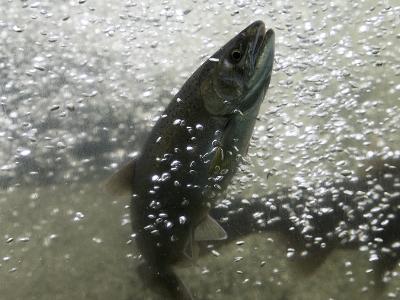U.S. organic aquaculture standards inch along
Organic seafood standards are slowly churning through the U.S. federal government’s approval process, but still with no clear timetable for finalization.
 Fishmeal-free Atlantic salmon feed formulation shows promise
Fishmeal-free Atlantic salmon feed formulation shows promise Joint research between TCFFI, USDA and EWOS uses new diet for post-smolt to food-size fish. a fishmeal-free diet on Atlantic salmon post-smolt performance
 Omega-3 levels fall in farmed salmon but it’s still a top source
Omega-3 levels fall in farmed salmon but it’s still a top source Researchers: Feed changes to increase sustainability have changed its nutritional profile, but farmed salmon still has few peers in omega-3s
 Studying the stubborn salmon disease SRS from afar
Studying the stubborn salmon disease SRS from afar UMaine researcher digging into Piscirickettsia salmonis to present at June conference. P. salmonis grown on a blood-agar based plate.
 Aquaculture viruses: An Atlantic salmon case study
Aquaculture viruses: An Atlantic salmon case study The Atlantic salmon is a very important aquacultured fish produced in several areas around the world, from western Canada to Tasmania.
 The ancient practice of paddy-cum-fish culture
The ancient practice of paddy-cum-fish culture Rural India entrepreneurs employ innovative, responsible approach combining fish and rice. Paddy cultivation in northeastern India..
 Opinion: Aquaculture’s way forward is to embrace zonal management
Opinion: Aquaculture’s way forward is to embrace zonal management Certification recognizes responsible production, but fails to account for external pathogens, pollution
 Parasite treatment reduces F. columnare infection in tilapia
Parasite treatment reduces F. columnare infection in tilapia The authors treated Trichodina with formalin in tilapia and determined fish survival following a bacterial challenge with F. columnare.
 Genetic improvement aids red tilapia growth in Egypt
Genetic improvement aids red tilapia growth in Egypt The goal of the breeding program at the Fish Research Center is to produce faster growing fish to benefit fish farmers in Egypt.
 Successful production of Nile and blue tilapia fry
Successful production of Nile and blue tilapia fry Findings based on degree days and demonstrated for earthen ponds in subtropical climates. Both Nile Tilapia (Oreochromis niloticus) and Blue Tilapia (O.aureus)
 Addressing safety in Latin America’s tilapia supply chain
Addressing safety in Latin America’s tilapia supply chain Successful farmers adopt conservative practices to avoid losses caused by biosecurity problems
 Adding value to tilapia to tap into U.S. market
Adding value to tilapia to tap into U.S. market Tilapia fresh fillets from various countries in Latin America are an important import product in the U.S., and consumers benefit from industry improvements
 Biofloc systems viable for tilapia production
Biofloc systems viable for tilapia production Mozambique tilapia (Oreochromis mossambicus) is a good candidate species for production in biofloc systems. Alterative method can increase feed efficiency
 What will it take to make tilapia great again?
What will it take to make tilapia great again? Affordable and right in Americans’ culinary wheelhouse, tilapia producers seek to regain foothold with consumers.
 Tilapia Farming in India A Billion Dollar Business
Tilapia Farming in India A Billion Dollar Business Tilapia farming is highly profitable, and tilapia farming in India is growing day by day. The largest producer of tilapia is China, Indonesia, Thailand
 Insect larvae as fish meal replacement
Insect larvae as fish meal replacement The use of insect meal in animal diets is promising. But what is the nutritional value of this protein and can it serve as a good replacement for fish meal
 Hawaii-based Fish 2.0 awardee tripling tilapia growing capacity
Hawaii-based Fish 2.0 awardee tripling tilapia growing capacity Hoʻoulu Pacific, an aquaponics company focused on spreading the benefits of tilapia farming to low income communities in the Hawaiian Islands and beyond
 Nitrite problem in Freshwater Fish Aquaculture
Nitrite problem in Freshwater Fish Aquaculture Nitrite enters a fish culture system after feed is digested by fish and the excess nitrogen is converted into ammonia, which is then excreted as waste into the
